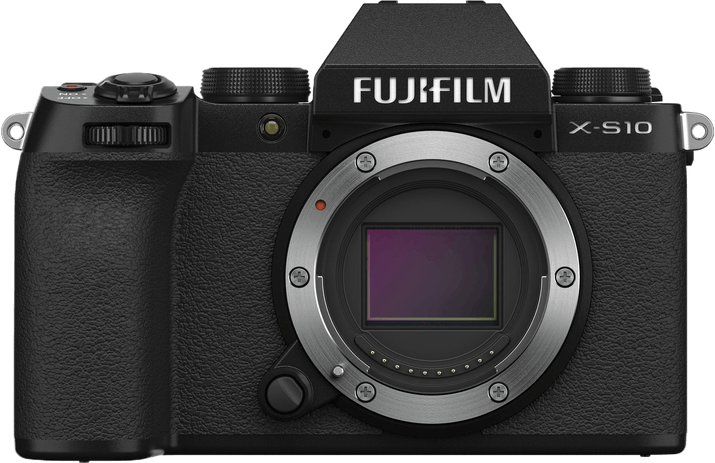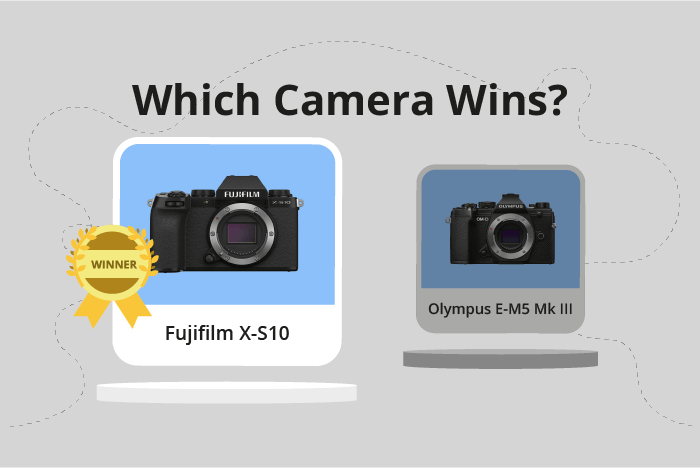Fujifilm X-S10 vs Olympus OM-D E-M5 Mark III Comparison
Fujifilm X-S10

Olympus OM-D E-M5 Mark III

The Fujifilm X-S10 takes the lead with a score of 69/100, while the Olympus OM-D E-M5 Mark III trails slightly behind at 65/100. Both cameras are mirrorless and share similar dimensions, with the X-S10 measuring 126 x 85 x 65mm and the E-M5 Mark III at 125 x 85 x 50mm.
The Fujifilm X-S10 has a few advantages, including a more recent release date in 2020 and a lower launch price of $999. This makes it a more budget-friendly option for those looking to invest in a quality camera.
On the other hand, the Olympus OM-D E-M5 Mark III is lighter at 414g compared to the X-S10’s 465g, making it easier to carry around for extended periods. However, it was released in 2019 and has a higher launch price of $1199.
Taking these specifications into account, the Fujifilm X-S10 emerges as the more attractive option due to its higher score, lower price, and more recent release date. Nonetheless, the Olympus OM-D E-M5 Mark III’s lighter weight may appeal to some photographers who prioritize portability.
Fujifilm X-S10 vs Olympus OM-D E-M5 Mark III Overview and Optics
The Fujifilm X-S10 outperforms the Olympus OM-D E-M5 Mark III in optics with a score of 72/100 compared to 60/100. Both cameras share common specifications, such as CMOS sensor type, image stabilization, and lens mounts specific to their brands. However, the Fujifilm X-S10 surpasses the Olympus OM-D E-M5 Mark III in certain aspects, while the latter camera also has its advantages.
The Fujifilm X-S10 has a higher megapixel count of 26 compared to Olympus’s 20 megapixels. This results in better image resolution and detail. Additionally, the X-S10 features a larger APS-C sensor size, providing superior image quality and low-light performance. The X-Processor 4 in the X-S10 is also a powerful processor, ensuring fast and efficient image processing.
On the other hand, the Olympus OM-D E-M5 Mark III has a faster shooting speed of 30 frames per second, compared to the X-S10’s 20 frames per second. This means the Olympus camera can capture fast-moving subjects more effectively. The Olympus camera also has a DXOMARK score of 55 for its sensor, while the Fujifilm camera does not have a DXOMARK score.
Despite the Olympus OM-D E-M5 Mark III’s advantages in shooting speed and a known DXOMARK score, the Fujifilm X-S10’s superior megapixel count, sensor size, and processing power make it a better choice for those prioritizing image quality. However, for users who need a faster shooting speed for action photography, the Olympus OM-D E-M5 Mark III may be a more suitable option.
Fujifilm X-S10 vs Olympus OM-D E-M5 Mark III Video Performance
The Fujifilm X-S10 and the Olympus OM-D E-M5 Mark III both receive a video score of 91 out of 100, indicating their strong performance in this category. With a tie in scores, it is essential to delve into their specific video capabilities to determine which camera is superior.
Both cameras share some common specifications, such as 4K maximum video resolution and 4096 x 2160 maximum video dimensions. Additionally, they each have built-in time-lapse functionality, which is a sought-after feature for videographers.
The Fujifilm X-S10 has an advantage in terms of maximum video frame rate, boasting a remarkable 240fps. This higher frame rate allows for smoother slow-motion video capture and better overall video quality. In comparison, the Olympus OM-D E-M5 Mark III offers a maximum video frame rate of 120fps, which is still impressive but falls short of the X-S10’s capabilities.
However, the Olympus OM-D E-M5 Mark III does not have any standout features that make it better than the Fujifilm X-S10 in terms of video capabilities. Both cameras offer excellent performance, but the X-S10’s higher frame rate gives it a slight edge over the E-M5 Mark III.
Considering the shared features and the Fujifilm X-S10’s superior frame rate, it is safe to say that the X-S10 offers better video capabilities. While the Olympus OM-D E-M5 Mark III is still a strong contender, the Fujifilm X-S10 proves to be the better choice for videographers seeking the highest quality and smoothest slow-motion video capture.
Fujifilm X-S10 vs Olympus OM-D E-M5 Mark III Features and Benefits
The Olympus OM-D E-M5 Mark III emerges as the winner with a feature score of 83/100, outperforming the Fujifilm X-S10, which has a score of 70/100. Both cameras share several specifications, including a 3-inch screen size, 1,040,000-dot screen resolution, touchscreen capability, flip screen, and Bluetooth connectivity. However, there are also differences that set these cameras apart.
The Olympus OM-D E-M5 Mark III surpasses the Fujifilm X-S10 in terms of connectivity, as it features built-in Wi-Fi. This allows users to transfer images and control the camera remotely, providing an edge over the X-S10, which lacks Wi-Fi functionality.
On the other hand, the Fujifilm X-S10 does not have any significant advantages over the Olympus OM-D E-M5 Mark III in terms of features. Both cameras are evenly matched in most aspects, with the Olympus model taking the lead mainly due to its Wi-Fi capability.
To conclude, the Olympus OM-D E-M5 Mark III is the better camera in terms of features, mainly because of its Wi-Fi connectivity. This advantage makes it more versatile and user-friendly compared to the Fujifilm X-S10. While both cameras share numerous specifications, the Wi-Fi feature sets the Olympus model apart, making it the preferred choice for photographers seeking enhanced connectivity options.
Fujifilm X-S10 vs Olympus OM-D E-M5 Mark III Storage and Battery
The Fujifilm X-S10 and Olympus OM-D E-M5 Mark III have the same storage and battery score of 35/100. Both cameras feature a single memory card slot and support USB charging. The X-S10 accepts SD, SDHC, and SDXC cards (UHS-I compatible), while the E-M5 Mark III is compatible with SD, SDHC, and SDXC cards (UHS-II compatible).
The X-S10 edges out the E-M5 Mark III with a slightly longer battery life of 325 shots, compared to the E-M5 Mark III’s 310 shots. The X-S10 uses an NP-126S battery, while the E-M5 Mark III uses a BLS-50 battery.
On the other hand, the E-M5 Mark III has an advantage in memory card compatibility, as it supports the faster UHS-II standard, which can potentially improve performance in certain situations.
Taking these factors into account, the Fujifilm X-S10 offers marginally better battery life, while the Olympus OM-D E-M5 Mark III provides greater flexibility in memory card performance.
Fujifilm X-S10 vs Olympus OM-D E-M5 Mark III – Our Verdict
Are you still undecided about which camera is right for you? Have a look at these popular comparisons that feature the Fujifilm X-S10 or the Olympus OM-D E-M5 Mark III:

